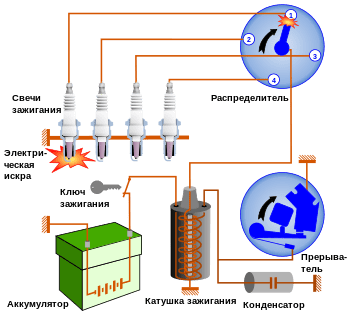
How does a car ignition system work?
Content
The complex process of a car's ignition system requires precise timing from the various systems involved. Starting a car takes much more than just turning the key in the ignition; it requires everyone...
The complex process of a car's ignition system requires precise timing from the various systems involved. Starting a car takes much more than just turning the key in the ignition; starting a vehicle requires each system to work in unison. After turning the key, the process of igniting the fuel and powering the engine begins. If the problem occurs somewhere along the way, the engine will not start and the vehicle owner must repair it.
A Matter of Time
Every system in an engine is tuned to work at a precise time during the combustion process. When this process does not work properly, the engine will misfire, lose power and reduce fuel consumption. After the key is turned, the starter solenoid is activated, allowing the voltage surge from the battery to reach the spark plugs via the spark plug wires. This allows the spark plug to ignite by igniting the air/fuel mixture in the chamber, which moves the piston down. The participation of the ignition system in this process occurs long before the formation of a spark and includes a set of systems designed to facilitate the process of spark formation.
Spark plugs and wires
The electric charge from the battery through the starter solenoid ignites the fuel-air mixture in the combustion chamber. Each chamber contains one spark plug, which receives electricity to spark through the spark plug wires. You must keep both the spark plugs and wires in good condition, otherwise the car may suffer from misfiring, poor power and performance, and poor gas mileage. You also need to make sure the mechanic inserts the gaps into the spark plugs correctly before installing them in the car. A spark occurs when an electric current passes through a gap. Spark plugs with the wrong gap lead to poor engine performance.
Other problem areas when it comes to spark plugs include deposit buildup in the electrode area. The make and model of a car helps determine if it is using cold or hot spark plugs. Hot plugs burn harder and thus burn off more of these deposits. Cold plugs come into play in high performance engines.
A good way to determine if the spark plug wire needs to be replaced is to start the car in a dark place. While the engine is running, inspect the wires from the spark plug to the distributor cap. Dim lighting will allow you to see any misplaced sparks in the system; tiny electrical arcs usually pop up from cracks and breaks in frayed spark plug wires.
Increasing voltage with ignition coil
Electrical voltage from the battery first passes through the ignition coil on its way to the spark plugs. Reinforcing this low voltage charge is the primary job of the ignition coil. Current flows through the primary coil, one of two sets of coiled wires inside the ignition coil. In addition, around the primary winding is a secondary winding, which contains hundreds of turns more than the primary winding. Breakpoints disrupt the flow of current through the primary coil, causing the magnetic field in the coil to collapse and creating a magnetic field in the secondary coil. This process creates a high voltage electrical current that flows to the distributor and to the spark plugs.
Rotor and distributor cap function
The distributor uses a cap and rotor system to distribute the high voltage charge to the desired cylinder. The rotor rotates, distributing charge to each cylinder as it passes contact for each. Current flows through the small gap between the rotor and the contact as they pass each other.
Unfortunately, the strong heat generation during the passage of the charge can lead to wear of the distributor, especially the rotor. When doing a tune up on an older vehicle, the mechanic will usually replace the rotor and distributor cap as part of the process.
Engines without distributor
Newer vehicles are moving away from the use of a central distributor and instead use a coil on each spark plug. Connected directly to the engine computer or engine control unit (ECU), it gives the vehicle control system finer control over spark plug timing. This system eliminates the need for a distributor and spark plug wires as the ignition system supplies charge to the spark plug. This setup gives the vehicle better fuel economy, lower emissions and more overall power.
Diesel engines and glow plugs
Unlike a gasoline engine, diesel engines use a glow plug instead of a spark plug to preheat the combustion chamber before ignition. The tendency of the block and cylinder head to absorb heat generated by compressing the air/fuel mixture sometimes prevents ignition, especially in cold weather. The glow plug tip provides heat as fuel enters the combustion chamber, spraying directly onto the element, allowing it to ignite even when it's cold outside.